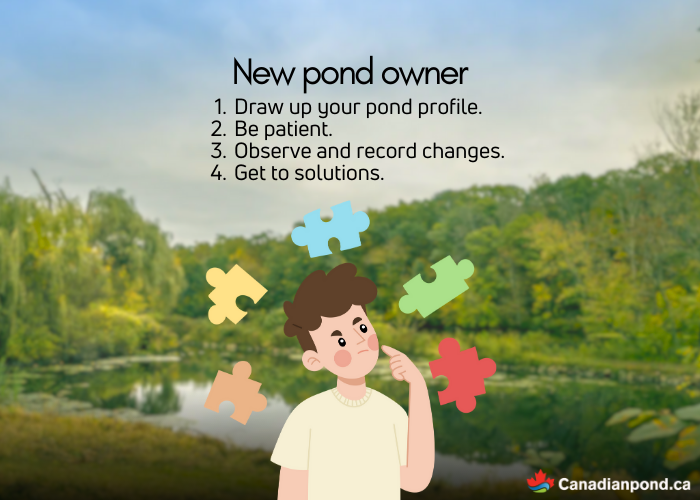New pond owner, where to begin!
New pond owner… where to begin!
Have you just purchased a new property with a water feature?
Or thinking of building a new pond or water garden?
If the answer to any of these questions is yes, then this article is for you! Being the new owner of a pond is exciting, and it can be tempting to take action quickly. It’s important to remember that the treatment of all ponds and lakes is not the same. Each pond has different characteristics and therefore its own treatment and aeration solution. So it’s important to get to know your pond first. Here are 4 tips to help you do just that.
Tip 1: Draw up a pond profile
The first thing you should do is draw up a profile of your pond. Here are a few points to consider:
• Dimensions
• Depth
• The age of your pond
• The flora and fauna of the water body
• Water inlet and outlet (if applicable)
• The number of hours of sunshine
• Riparian buffers
If you’ve purchased a property where there was already a pond, we recommend that you talk to the previous owners. They could provide you with information relating to the points above, such as the age and depth of the pond. It would also be useful to find out whether they have carried out any treatments in the past, and if so, which ones.
2nd tip: Patience is a virtue
Patience is an ally when you’ve just acquired a body of water. Indeed, it will show you many signs of its state of health over a period of weeks or even months, unlike a swimming pool, which will show signs quickly. Since these are natural, non-isolated ecosystems that changes with the seansons, they take longer to notice changing conditions. So be patient!
3rd tip: Observe and record changes
In your first year as a pond owner, we suggest you observe and record what’s going on. Don’t hesitate to take photos and notes several times during the year. This will enable you to see the changes clearly, since they take place over a long period of time. One of the signs most noticed by customers, is an accumulation of algae on the surface. This could mean that your lake is lacking oxygen. Several hypotheses are possible, which is why it’s a good idea to take notes. It’s important to keep an eye open and get to know your pond.
To learn more about the presence of algae in your pond, we invite you to read this article: Algae or aquatic plants: How to tell them apart?
4th tip: Possible solutions
After the observation phase of getting to know your pond, there are several solutions open to you. Sooner or later, aeration will always be a welcome addition to your pond’s ecosystem.
Often, the cause of many problems is not enough oxygen in the water, preventing beneficial living beings (bacteria, fish) from developing and flourishing. Adding an aeration system is often the first solution we recommend, as it increases oxygen levels, reduces algae growth, evacuates toxic and odorous gases and reduces fish mortality. If you have any questions about aeration, you can read the following article: Don’t cause a turnover, slow start your aeration system. This article will advise you on how to integrate an aeration system gradually, without compromising the health of your pond.
Another solution, which can complement aeration, is bioaugmentation. What is bioaugmentation? It’s the addition of beneficial bacteria to the water to keep your pond healthy. However, as bacteria are living creatures, they also need oxygen to survive. It’s important to have an aeration system that will provide the necessary oxygen. Without an aeration system, bacteria won’t be as effective as they could be. To find out which type of bacteria are best suited to your situation, go to the Bioaugmentation Q&A page.
In conclusion, despite the excitement and novelty of a new body of water, patience is key. It’s important to know and understand your pond so that we can provide the necessary and appropriate resources. Take note of the pond’s condition and changes, then contact us! We’ll be happy to help!
